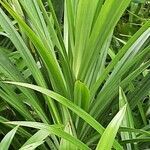Herbs evergreen. Stems branched; aerial roots present. Sucker shoots of small growth phase with stems slender, 1-1.6 m × 2-5 cm, decumbent and ascending; leaves 25-75 × 2-5 cm, somewhat glaucous abaxially, keeled abaxially but unarmed, margin entire except at apex, there with very few minute prickles less than 1 mm, apex with distinct twin lateral pleats; flowers unknown, probably never produced in small growth phase. Large growth phase with stems 2-4.5 m × ca. 15 cm, erect, not or only sparsely branched; leaves broadly linear, to 150-220 × 7-9 cm, glaucous abaxially, keeled abaxially and with twin lateral pleats with prickles same as in small growth phase, apex acute; female inflorescence unknown; male inflorescence (evidently exceedingly rare) probably pendent, to 60 cm; spathes ca. 90 cm; spikes cylindric, to 35 cm or more, upper ones much shorter, 9-10 × ca. 2 cm, of numerous crowded, flat staminal phalanges 1.5-2.5 mm wide; stamens mostly 3-6 per phalange; filaments 0.5-1.5 × 0.4-0.6 mm; anthers oblong, ca. 2.5 × 0.5 mm, apex bluntly convex, without or with a barely discernible apiculum.
More
A shrub 2-4 m tall. Often the plant is small due to repeated cutting. It can grow 8 m tall. There are stilt like aerial roots on the stems near the base. It develops suckers and forms clumps. The leaves are arranged in spirals. The leaves are narrow and folded like a fan. They have sharp edges. They are 75 cm long and 2.5 cm wide. They droop about half way along. The plant rarely flowers. The flowers are white and the fruit heads are 20 cm across.

